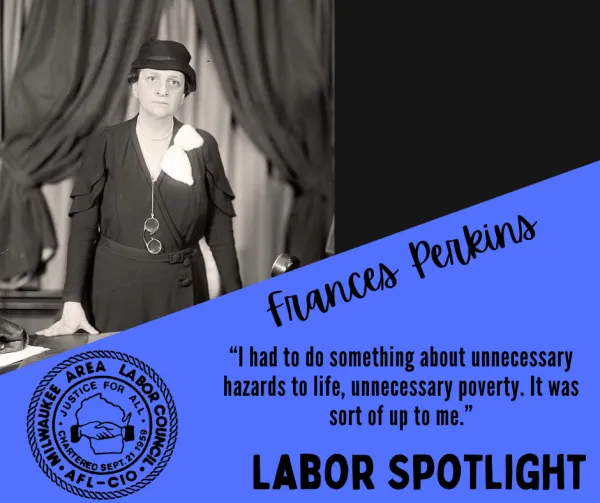Labor Spotlight- Frances Perkins

Perkins was born in Boston in 1880, descendant from a long line of Maine farmers and craftsmen. At Mount Holyoke College, she studied the natural sciences and economic history and was exposed to a variety of works and lectures who exposed her to new ways of thinking about the social problems she witnessed.
After graduation, she learned more about the plight of working people when she volunteered in New York's settlement houses. She heard stories directly from workers about the dangerous conditions of factory work and the desperation of being unable to collect promised wages or secure medical care for workplace injuries. She left her teaching career, just as it was beginning, to earn a master's degree in economics and sociology.
In 1910, she became secretary of the New York Consumers' League and was part of a team that lobbied the state legislature for a bill limiting the workweek for women and children to 54 hours. On March 25, 1911, she was attending a social function near the Triangle Shirtwaist Factory when the fire began. She witnessed the entire event. The results were obvious.
Perkins began to focus more on practical remedies to the challenges faced by working people. She held to a strong belief that legislation was the most important avenue to "right industrial wrongs," and she simultaneously championed labor organizing and collective action. In 1918, she was invited by Gov. Al Smith to join the New York State Industrial Commission, becoming the first woman to serve. By 1926, she had become the commission's chairwoman. In 1929, Gov. Franklin Roosevelt appointed her as the industrial commissioner for the state. She led a series of progressive reforms that included expanding factory investigations, reducing the workweek for women to 48 hours and championing minimum wage and unemployment insurance laws.
In 1933, Perkins was chosen by President Roosevelt to serve as secretary of labor, making her the first woman ever appointed to a federal Cabinet position. She focused on creating a safety net to counteract the Great Depression's effects on working people. This was evident in the legislation she helped secure, including the Wagner Act (which gave workers the right to organize unions and bargain collectively), the Fair Labor Standards Act (which established the first minimum wage and created a maximum workweek) and the Social Security Act of 1935.
She also played a crucial role in the dramatic labor uprisings of the 1930s and 1940s. She consistently supported the rights of workers to organize unions of their own choosing and to pressure employers through economic action. She successfully resolved strikes with gains for workers time and time again, most notably helping end the 1934 San Francisco General Strike without violence or the use of federal troops, an option that was on the table.
In 1945, Perkins resigned from her position as labor secretary to head the U.S. delegation to the International Labor Organization conference in Paris. President Harry Truman appointed her to the Civil Service Commission, a job she held through 1953. She also returned to the classroom to teach at Cornell's School of Industrial and Labor Relations. She died in New York in 1965 at the age of 85 and was buried in her family's plot in New Castle, Maine.
Source: aflcio.org